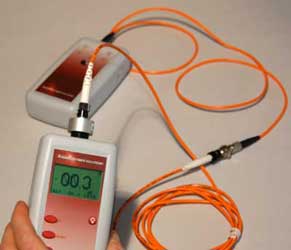The Duty of Optical Fibre Testing in Ensuring High Quality and Effectiveness in Connectivity Solutions
In today's rapidly progressing electronic landscape, the relevance of optical fiber testing can not be overstated, as it offers as a foundation for ensuring the high quality and effectiveness of connection solutions. As modern technology continues to development, the future of optical fibre screening poses intriguing challenges and opportunities that warrant closer exam.
Value of Optical Fibre Screening
The significance of optical fibre screening can not be overstated in making certain the stability and efficiency of communication networks. As the backbone of contemporary telecoms, optical fibres assist in high-speed data transmission, making their dependability important to functional success. Testing acts as a proactive measure to determine potential issues such as signal loss, depletion, and physical damages, which can compromise network efficiency.
Regular screening permits the verification of setup quality and the discovery of problems that can influence data stability - ofda. By using rigorous screening protocols, network operators can alleviate the dangers related to network failures, consisting of downtime and economic losses. Moreover, optical fibre screening ensures conformity with sector standards and laws, enhancing the general top quality of solution offered to end-users.
Eventually, the systematic evaluation of optical fibres adds to the long life and performance of communication systems. It allows stakeholders to make educated choices pertaining to upkeep, upgrades, and troubleshooting. In a landscape where information is progressively vital, prioritizing optical fibre testing is vital to sustaining durable and reliable connectivity remedies, thereby supporting the needs of contemporary digital settings.
Kinds Of Optical Fibre Examinations
Numerous screening techniques are utilized to ensure the capability and reliability of optical fibers within interaction networks. These examinations can be broadly categorized right into 2 primary kinds: installation examinations and upkeep tests.
Installation examinations are carried out instantly after the setup of optical fiber cables to confirm their performance and stability - robotic vision. The most common installation tests consist of Optical Time-Domain Reflectometry (OTDR) tests, which analyze the quality of the fiber by determining faults or breaks, and end-to-end loss examinations, which measure the complete optical loss from one end of the fiber to the other
Maintenance tests, on the other hand, are done regularly to guarantee continuous efficiency and spot prospective issues gradually. These include aesthetic examination, which look for physical damages or incorrect installments, and connection tests, which validate that the signal can go through the fiber without interruption.
Additionally, progressed examinations such as Polarization Mode Dispersion (PMD) and Chromatic Diffusion (CD) examinations can be performed to review the fiber's efficiency under different conditions. By utilizing these diverse screening approaches, technicians can keep high requirements of high quality and dependability in optical fibre networks.
Benefits of Routine Examining
Routine screening of optical fibres plays an important function in preserving the total efficiency and reliability of communication networks. By conducting regular evaluations, organizations can guarantee that their fibre optic setups meet industry criteria and operate successfully. This aggressive method aids to recognize prospective weaknesses and deterioration in time, permitting prompt interventions before concerns rise.

Cost-effectiveness is another advantage. By resolving small concerns early, organizations can prevent the high prices linked with significant repairs or system failures. Normal testing also promotes conformity with regulative demands, making certain that the network follows needed safety and security and efficiency criteria.
Usual Issues Identified
Determining usual issues in optical fiber networks is essential for maintaining ideal efficiency and reliability. Numerous elements can add to disruptions, consisting of physical damages, bad installment methods, and environmental impacts.
Physical damages, such as bends, breaks, or abrasions, can considerably degrade signal quality. Inappropriate installation methods, including extreme tension why not find out more or poor safeguarding of cable televisions, might bring about boosted depletion and loss of connectivity. In addition, environmental aspects such as temperature level changes, wetness access, and rodent interference can compromise the stability of the fibre.
Connector concerns likewise regularly occur, with inappropriate positioning or contamination resulting in raised insertion loss. Additionally, splicing mistakes can introduce significant signal destruction continue reading this if not performed with precision.
Addressing these usual issues through normal optical fibre screening not only enhances network integrity however also enhances overall performance, making sure that connection services continue to be robust and reliable.
Future Fads in Checking
As the need for high-speed connection proceeds to increase, the future of optical fiber screening will significantly concentrate on automation and advanced analytics. The assimilation of fabricated intelligence (AI) and maker knowing (ML) in screening procedures will allow more effective information analysis and predictive upkeep, reducing downtime and boosting total network integrity. Automated screening options will certainly simplify the examination and certification of fibre networks, lessening human mistake and increasing testing throughput.
An additional considerable pattern is the fostering of remote testing modern technologies. As the deployment of fiber networks broadens right into remote and underserved areas, remote testing abilities will allow professionals to monitor and identify network problems without physical presence, therefore minimizing operational expenses and improving response times.
Furthermore, there will certainly be a change towards even more extensive testing criteria that encompass not only traditional loss measurements yet also performance metrics such as latency and bandwidth use. go to my blog This alternative technique will promote much better network management and optimization techniques.
As these fads advance, the optical fiber screening landscape will not just enhance the quality and performance of connectivity services but also sustain the growing intricacies of contemporary interaction networks.
Verdict
In verdict, optical fiber testing serves as a basic part in maintaining the stability and effectiveness of interaction networks. The continuous commitment to routine screening not only boosts data transmission however also straightens with industry standards, fostering dependability in network frameworks.